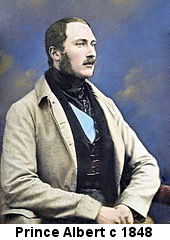Loch Lomond
(See also the entries in the Loch Lomond Steamers Page)
Loch Lomond is the largest area of freshwater in Great Britain covering 27 square miles. It is arguably, and Vale folk would certainly argue it, the most beautiful loch, lake or any other place of natural beauty in the British Isles and perhaps the world, encompassing the hills and mountains, rivers and streams, studded with islands and guarded by Ben Lomond, sitting overseeing it all like some biblical patriarch. However, enough of the understatement.
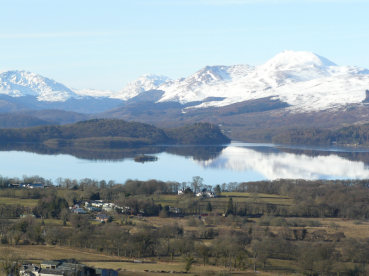
This beautiful image of Loch Lomond was taken from the top of Duncryne Hill
(The Dumpling) in perfect conditions on 2 March 2010. It was used as a backdrop
to the BBC weather forecast on Wed 3 March 2010. (Mouse over to enlarge.)
There are some things which the Loch is not and we should dispose of them up front. At about 22.5 miles long, (at its widest it is just over 5 miles wide), it is not the longest loch in Scotland - both Loch Awe with its dog-leg, and Loch Ness straight as a die at 23.5 miles, are longer. Nor is it the deepest. Loch Morar in the Northwest Highlands at 1,017 is the deepest, and there are other lochs which are deeper than the Loch's 623 feet just north of Tarbet, but that depth is quite enough to be getting on with if you fall in.
Loch Lomond was gouged out by a melting glacier at the end of the ice age, like so many other Scottish Lochs, which gives it its fiord-like appearance, particularly at its northern end. The glacier left a number of islands, which give the loch its almost unique appearance. Loch Maree also has a number of islands, but not on the scale of Loch Lomond. How many islands there actually are soon degenerates into a debate about what is an island and what is a rock, but let's settle for more than 20 and less than 40.
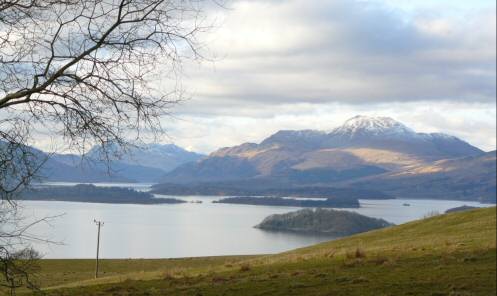
Thirteen of the islands have “Inch” in their names, and 3 have permanent residents while another 2 have summer homes. There were medieval castles on at least 4 of the islands, which sheltered the Earls of Lennox (forebears of the Stuart Kings), the Galbraiths and the McFarlanes.
Seven main tributaries feed the Loch, while its only outflow is the River Leven. Two of these tributaries - the Falloch in the north and the Endrick in the southeast - drain large areas of the centre of Scotland. Both are Watershed Rivers, which flow within a few miles of the sources of the two great East coast Rivers, the Tay and the Forth.
The Loch is the point at which the Highlands meet the Lowlands and
indeed the Highland geological fault runs across the Loch just south of
Luss through a string of islands to emerge at the foot of the Conic Hill
at 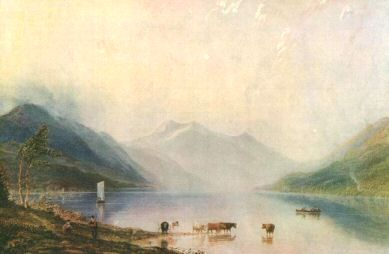 Balmaha. Two cultures met on its shores, and for many centuries clashed
there in raids and feuds. It is no accident that it was Lochside clans
which fought out the last clan battle in Scotland, in Glen Fruin in 1603,
just a couple of miles as the crow flies from the Loch. That battle was
Highlander versus Lowlander, and, more than the Jacobite risings of the
18th century, was the last hurrah of the Highlander plundering the Lowlands
at will.
Balmaha. Two cultures met on its shores, and for many centuries clashed
there in raids and feuds. It is no accident that it was Lochside clans
which fought out the last clan battle in Scotland, in Glen Fruin in 1603,
just a couple of miles as the crow flies from the Loch. That battle was
Highlander versus Lowlander, and, more than the Jacobite risings of the
18th century, was the last hurrah of the Highlander plundering the Lowlands
at will.
It probably didn't seem that way to the Grahams and the people of Strathendrick and the Lochside when Rob Roy was in his prime, but he avoided bloodshed on the whole, and was motivated by justified grievances as much as greed. A good example of this was Rob Roy's Raid of 1715 supposedly in support of the 1715 Jacobite Rebellion, but mainly in support of himself. His sally down the Loch and into the Vale of Leven comes as no surprise, but perhaps the competence of the retaliatory combined operations Loch Lomond Expedition conducted by the Army and Royal Navy, does. There were no reported casualties on either side, and both sides seem to have been equally happy with the outcome.
Long before either, of course, the Vikings had sprung their own Loch Lomond raid in 1263, prior to the battle of Largs, when they dragged their longboats from Arrochar to Tarbet and laid waste to farms and crofts on the Loch shore and the islands, before sailing down the Leven to the Clyde, and on to meet defeat at Largs.
The
Loch, and the tracks along its shores, were for many centuries an important
line of communication between the western Highlands and the central Lowlands.
Cattle drives came down both sides of the Loch from time immemorial. As
Glasgow grew so did these drives, particularly from the 16th century. By
the 1700's even more
cattle were being driven to the great market at Crieff, and they were driven
along the northern part of the eastern shore en route to Crieff. After
Falkirk Tryst became the main Scottish cattle market about 1770, the cattle
drives switched to the western shores to cross the Leven at Balloch or
Bonhill.
By this time the Loch shore road from Tarbet to Dumbarton was a military road. Its firm surface, which so impressed Dr Johnston on his visits to Rossdhu and Cameron House when returning from his tour of the Hebrides in 1773, took a heavy toll on the cattle's hooves. And when expensive tolls were introduced to pay for the upkeep of these roads from 1790 onwards - Loch Lomondside being particularly badly hit by Colquhouns tolls - the drovers quite literally took to the hills above the Loch.
For a time they also swam their cattle across the Loch from Inverbeg to Rowardennan. By the time the toll roads were abolished - officially in1878, but it took Dunbartonshire another 5 years to implement the Act which abolished them, the cattle drives had given way to cattle trucks on the railways. From the early middle ages the Loch was busy with boats carrying both people and goods - the wood for the rafters of Glasgow Cathedral was felled at Luss and transported to Glasgow by water via the Loch, Leven and Clyde.By the 18th century boats were carrying wood, slate and stone quarried in Lochside quarries - for instance from a small port at the Aber - to Clydeside. They brought back bulk cargo such as fertiliser.
When the loch lomond steamers arrived in 1818, in the shape of the Marion, which sailed from Balloch to about Inversnaid, they were at first passenger transport ships. Their passengers were the early affluent, usually Glasgow-based tourists, who were following in the wake of a few celebrity tourists such as Johnston and Boswell, the Wordsworths and Coleridge who all had to visit the Loch by coach.
(See the Separate Entries in the Loch Lomond Steamers Page)
Soon there were competing passenger steamers on the Loch and then cargo- carrying ones, which competed with the existing sailing scows for the business of carrying slates, wood and stone out of the Loch and coal and many domestic goods in. It was this water-based business which first attracted the railway to Balloch. The original plan was a Glasgow - Balloch Pier line, but when they couldn't fund that, they were so keen to get into the Loch steamer business that they settled for a Balloch - Bowling porterage line which meant loading trains at Balloch with passengers or cargo and taking them by rail to Bowling where they were transferred to a boat on the Clyde for the 1 hour journey to Glasgow.
In anticipation of the railway's arrival, in 1846 a substantial pier of over 300 feet had been built at Drumkinnon Bay, and the centre of passenger operations moved from the area on the Leven in front of the Balloch Hotel to the Bay. Balloch Pier would have been built at that time anyway for operational reasons, but a tragedy at Tarbet in 1846, when a number of passengers were drowned during a steamer-to-shore transfer, hastened the building of piers in the next few years, at all of the steamer stops.
When the railway arrived
at Balloch Pier, the Lochside infrastructure was largely in place for their
passengers, and remained so for the next hundred years. Balloch became
quite a viable small port with a flotilla of very attractive steamers.
Their numbers varied, but from 1860's until the WW1, there would
be 3 / 4 at any one time - they also sailed all year round. And they
attracted royal patronage including the 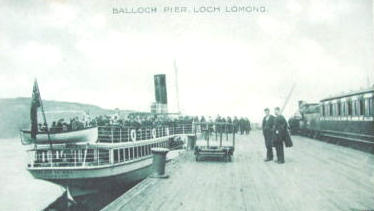 Empress Eugenie of France, and
Queen Victoria (who, a few years after Prince Albert's death, sailed in a steamer called
the Prince Consort and said how touched she was that that steamer had been
chosen for her journey).
Empress Eugenie of France, and
Queen Victoria (who, a few years after Prince Albert's death, sailed in a steamer called
the Prince Consort and said how touched she was that that steamer had been
chosen for her journey).
See foot of column on the right for an account of the Royal Visit in 1849.
In this century both the Queen and the Duke of Edinburgh have sailed on the Maid of the Loch, but were beaten to it by Queen Salote of Tonga who visited the Loch a few weeks after the Maid's launch and a few days after the Queen's Coronation in 1953.
As well as the steamers, smaller pleasure craft had started to edge their way onto the Loch by the late 18th / early 19th century. To begin with, the gentry dominated the new water based recreations, such as angling sailing and rowing. There was nothing surprising about that because they were the only people with the leisure time and money to indulge in such pleasures.
The first rowing regatta was held in 1828 and involved crews from the mansions on the Lochside. By the 1850's, however, it was workmen from the Vale who dominated the sport, and by the 1860's Loch regattas attracted thousands of spectators brought to Balloch on special trains, with the boats lashed to the carriage roofs. Big money, for the day, was at stake in prizes and betting. By the 1880's and 1890's small pleasure boats could be acquired by working people and photographs of the River Leven in the early 1900's show how many boats were beginning to be moored there.
It was the 20th century before angling on the Loch and its tributaries became easily available to the working man. One sad measure of how busy the Loch and Leven was becoming was that the Humane Society was formed at Balloch about 1875, and its objective was the recovery of bodies drowned on the Loch and Leven.
All of the pleasure activity was not exclusive to Balloch. Balmaha was recognised as a good anchorage, and anglers and pleasure craft sailed from there. A boatyard was opened by the McFarlanes, like the one already operating at Balloch by the Lynns from the late 1870's, to service this growing pleasure boat fleet. The McFarlanes also acted as postmen to the residents of the islands. Until the 19th century a number of the islands had been inhabited, ostensibly by keepers from the big estates who also doubled up by crofting and farming.
Most Lochside residents whether on the islands or the mainland moorlands and hills, were also involved in the illicit distilling of whisky. The topography was ideal for hiding illicit stills. The government perceived this as such a problem on the islands and the shores of the Loch, that they put an Excise cutter onto the Loch for a number of years in the early 1800's. There is no record of any great success for the boat, but at least it provided work for 4 - 5 men.
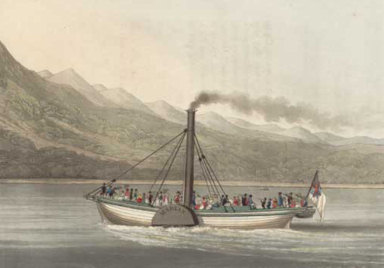
The first half of the 19th
century saw the building of many of the grand mansions at the southern
end of the Loch, as well as most of the Lochside hotels. The start of the
20th century saw the beginning of the golden age not just of Loch “mass” tourism
but also of co-operative Loch usage, when each different type of recreation
happily co-existed with the others. This lasted until the 1960's.
< ‘A Trip up Loch Lomond', from M Egerton, Airy Nothings... by Olio Rigmaroll, London 1825.
The years of economic depression of the 1920's and 30's provided many people with an abundance of unwanted free time and many spent it on and around the Loch, providing them with a much-needed escape. It was at this time that the Loch and its surrounding hills began to be called “Glasgow's Lung” by its grateful citizens. In the summer, the beaches on the Loch seemed to be as busy as the Spanish costas today, with favourites like Inchmoan and the Fruin shore already full of boats by early morning.
Loch Lomond Filmed in Colour in 1926
The British Film Institute: "In the summer of 1924 Claude Friese-Greene, a pioneer of colour cinematography, set out from Cornwall with the aim of recording life on the road between Land's End and John O'Groats. Entitled The Open Road, his remarkable ground-breaking travelogue was conceived as a series of shorts, 26 episodes in all, to be shown weekly at the cinema."
This brief but fascinating clip is from the section of Friese-Greene's film, which was filmed on Loch Lomond. It is almost certainly the first recorded colour film of the Loch.
The shots of Balloch Castle are taken from the north side and the front, which is quite unusual as most of the old photos are of the front and the south approach on the main drive. A few other points are worth making.
1. The opening shots were taken in the small garden just to the north of Balloch Castle, which had a sunken fountain at its centre. The fountain can be seen functioning in this film but it was removed and the sunken area filled in many years ago. The fountain is in the middle of the picture.
2. Its very striking how many trees there were so close to the front of the Castle, a testimony to the love of trees of 19th century owners Stott and Dennistoun Brown. As shown in the film, the view over the Loch from the path at that time was almost totally obstructed by trees, large and small. Is is likely that as the park was more used by the public many of the trees were removed to provide the unobstructed view that we all enjoy today. Some of the larger trees that remained have also been lost to gales in recent years.
3. A couple of steamers can be seen moored to the North of Drumkinnon Bay. There is not enough detail in the film to clearly identify them but at that time the steamers Prince George, Princess May and Prince Edward were all in operation. Two of these can be seen. Perhaps the other was out on the Loch as the film was being made.
4. The view up the river from what was Lynn's yard hardly changed until the early 1960's. It will still be recognisable to locals.
5. Towards the end of the film there are shots of two rowing boats. The first, with two people in the boat, is on the river just below the Balloch Hotel and off Monkey Island, which appears to have been much larger in these days. The second has three people in the boat including two women with a parasol. This is almost certainly of the houseboats on the Loch at Aldochlay/Camstradden, near Luss. There was a fair number of houseboats moored there at that time (and beyond).
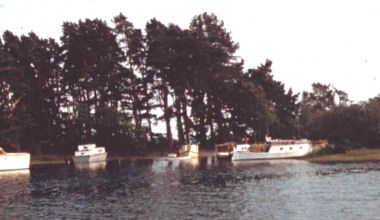
The general affluence of the 1960's saw two developments which had
a big impact on the Loch as well as elsewhere in Scotland - people
going abroad on holiday, and the proliferation of fast motor boats mostly
owned by people with no previous connection with the Loch and ignorant
of safe and sensible standards of behaviour.
A Flotilla on Inchmoan in the 1950s >
The Maid of The Loch, the last paddle steamer to be built in Britain, which was launched at Balloch in 1953, made its last sail in 1981, and while Alloa Brewery Co bravely brought the much smaller Countess Fiona onto the Loch and she sailed until 1989 (by which time she was under new ownership), the era of the Loch steamer was over.
A new type of Loch users had arrived, and shortly after them a succession of entrepreneurs seeking their pot of gold in the waters of the Loch. Virtually all of them ignored the wise words of the late and much missed John Sweeney, boat-hirer at Balloch - “anyone who wants to make a small fortune out of Loch Lomond, had better start with an incredibly big one.”
Big changes took place both on the Loch and on its shores, only a few of which could be described as improvements by any standards. Alive to the problems facing the Loch, a couple of new organisations were formed, the most practical of which was a grouping of people who actually spent most of their time on or around the Loch - The Loch Lomond Users Association, which was formed in the mid 1970's. Representatives of hoteliers, boat-hirers, marina-owners, anglers, speed-boat owners, water-skiers, rowers, the local authorities and members of the public met once a month to thrash out problems, and these solutions evolved into a Code of Conduct, and informal rules of behaviour.
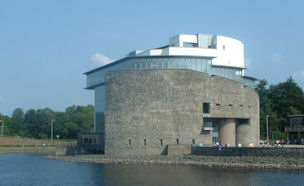
It did much practical good, but naturally
when the National Park Authority was formed, it was ignored. The Loch is
too grand to be seriously damaged by the likes of the National Park Authority
and Lomond Shores, both creations of 21st century public expenditure.
< The Main Building (now an aquarium) at Loch Lomond Shores
The two private golf courses, one opened in 1994, the other 2007, on the western shore are attractive, if exclusive, additions.
To non-golfers they are of limited interest, to many golfers they are either too expensive or unavailable. It would make a pleasant change to see some Lochside developments which could be welcomed by the great majority.



